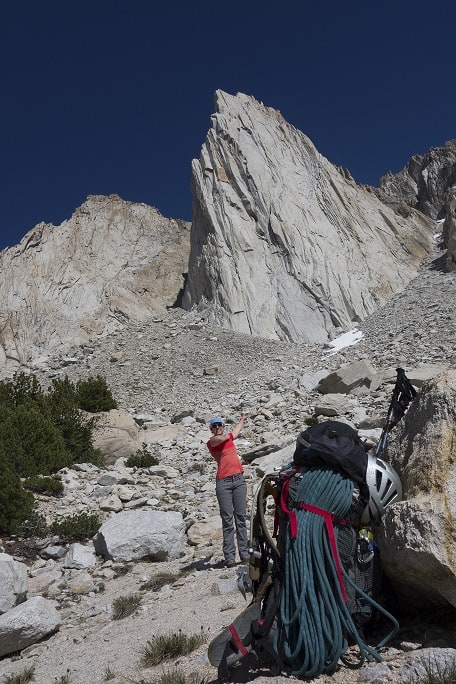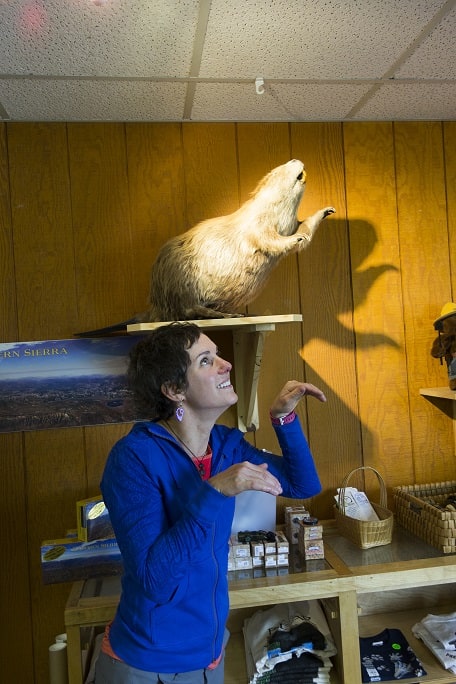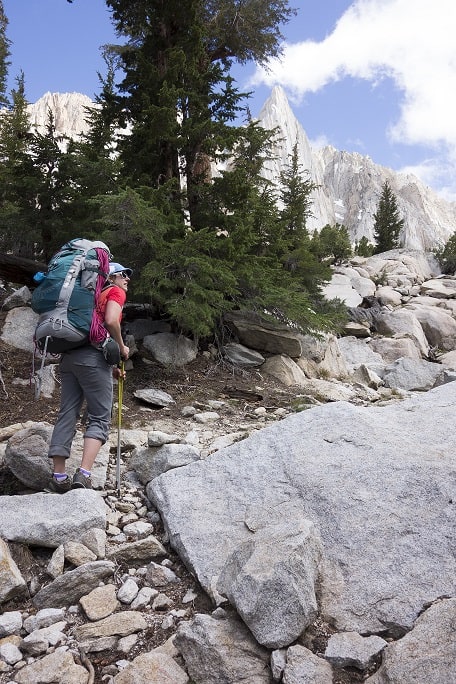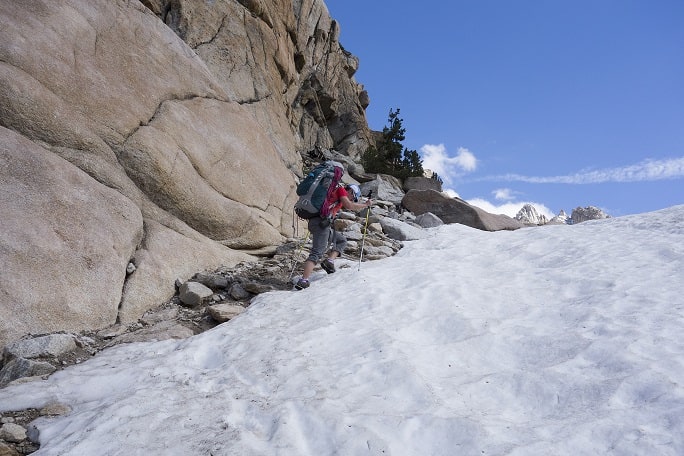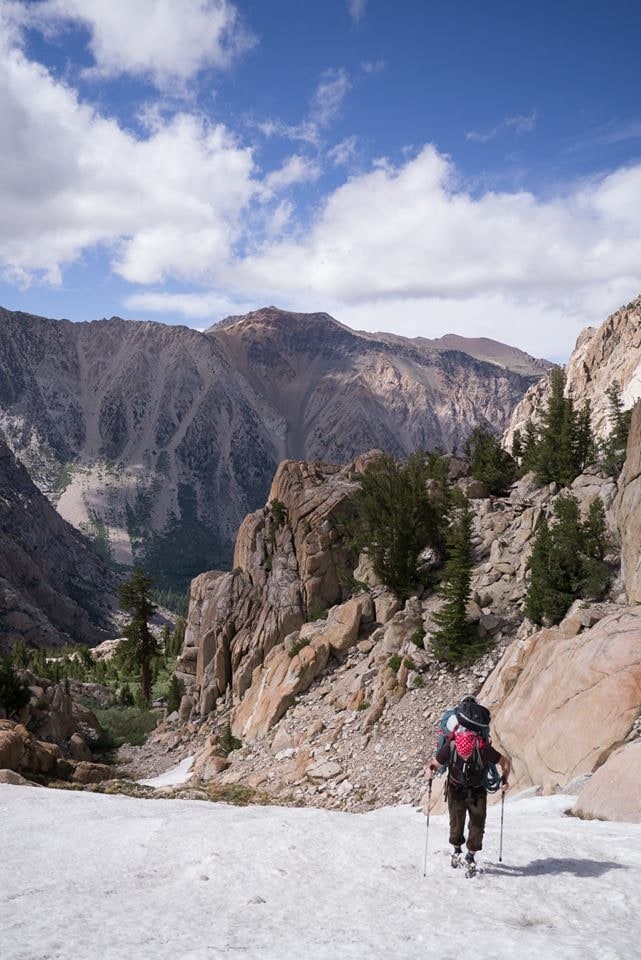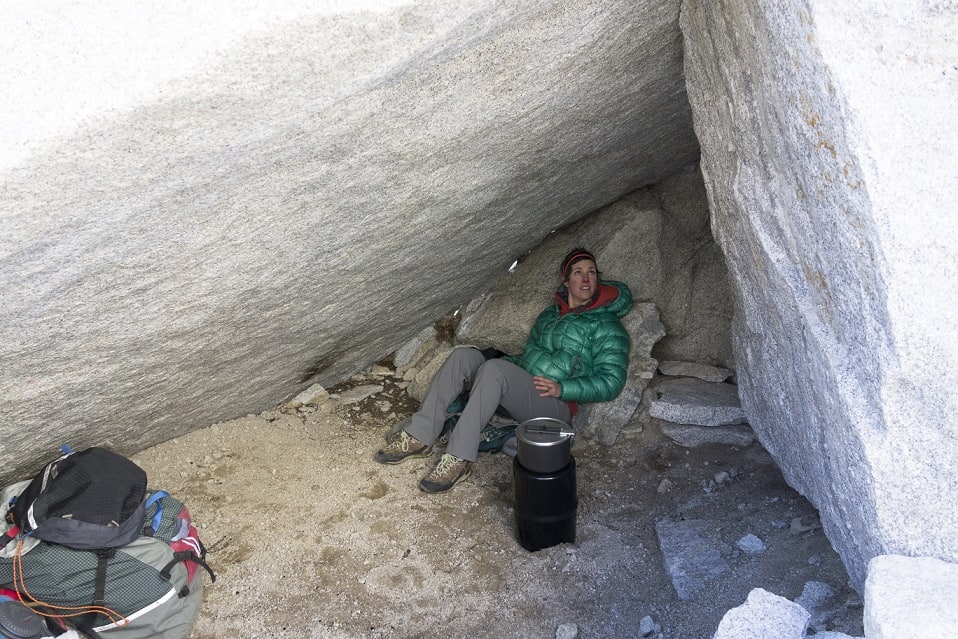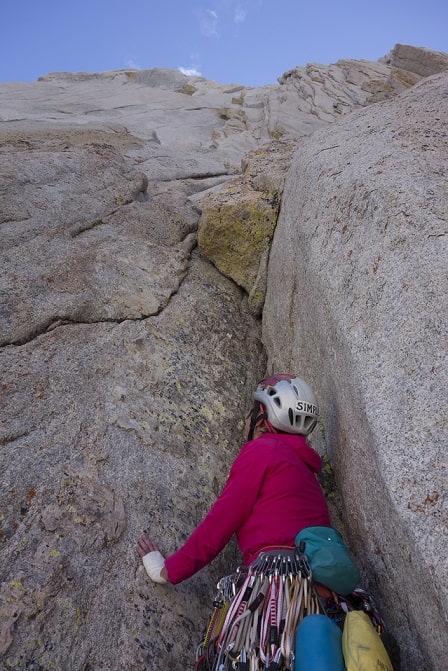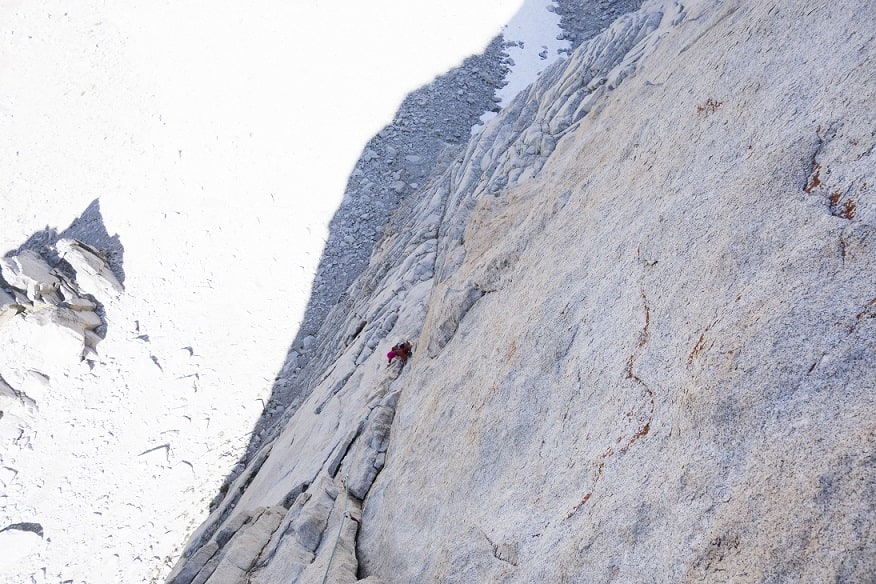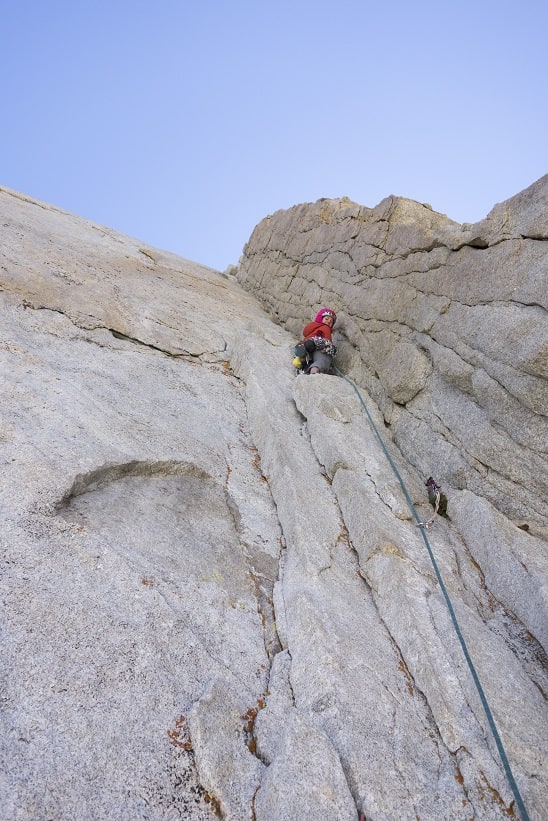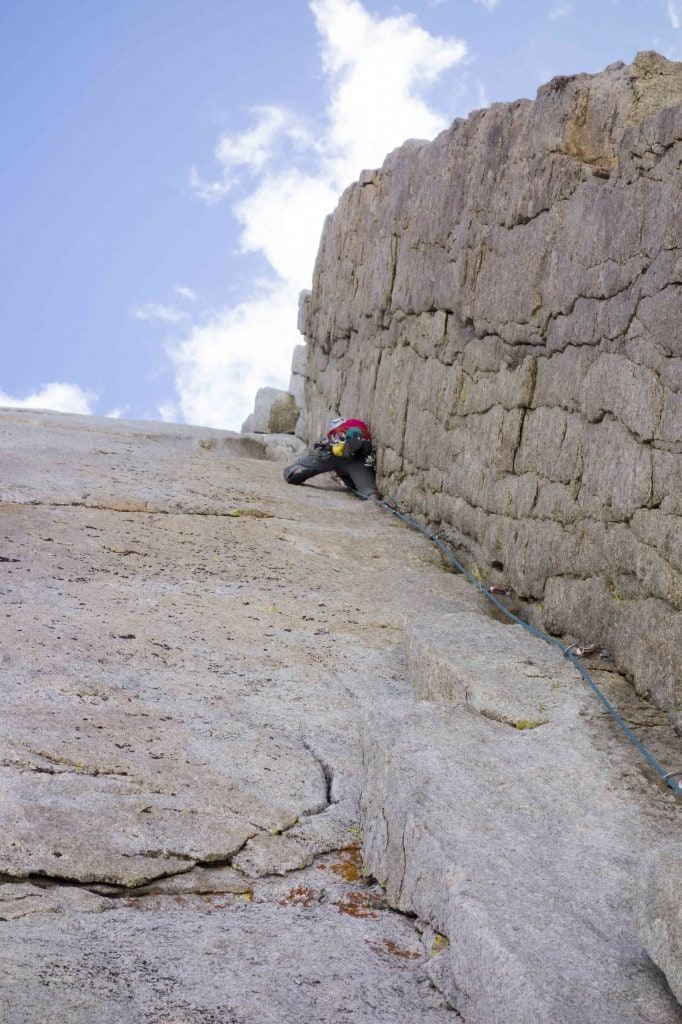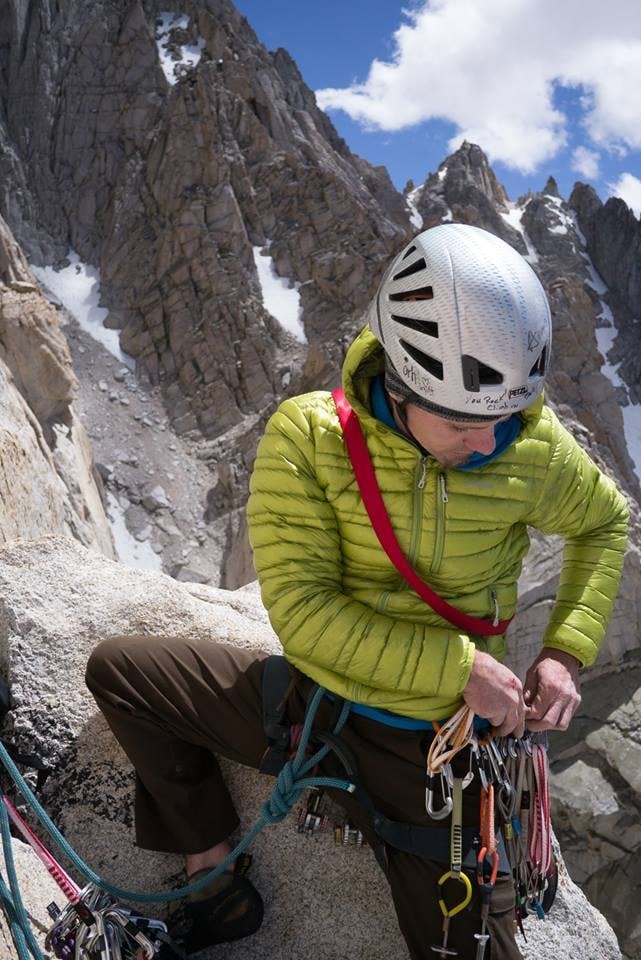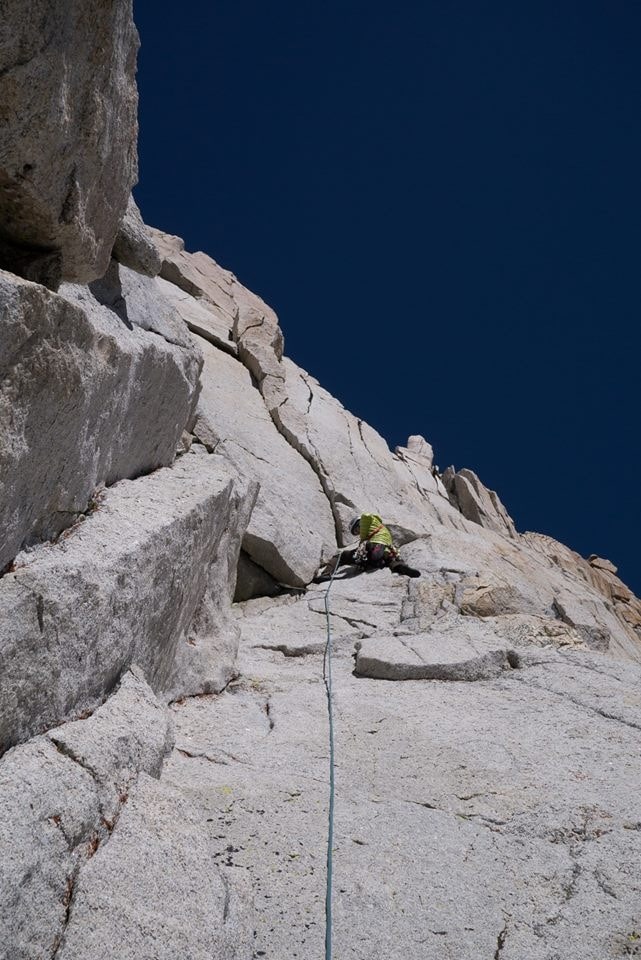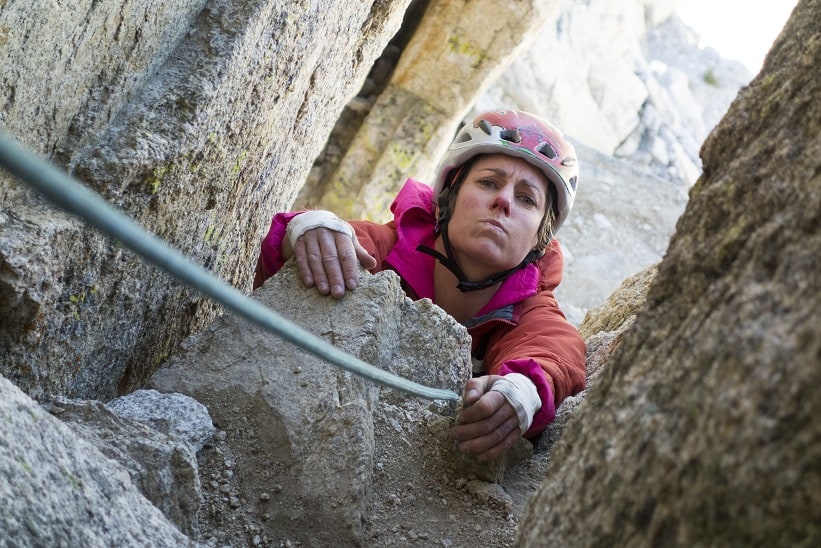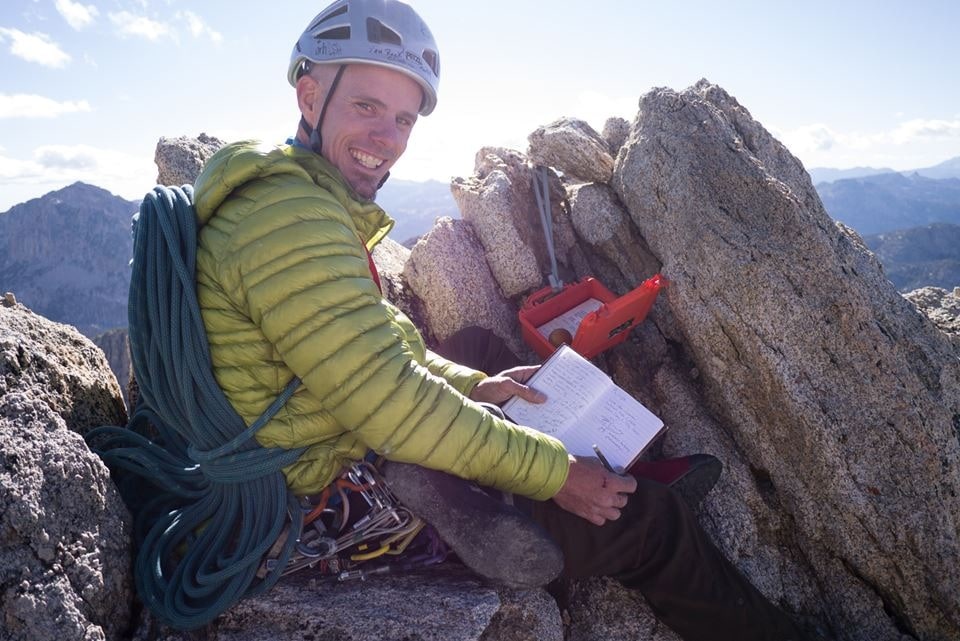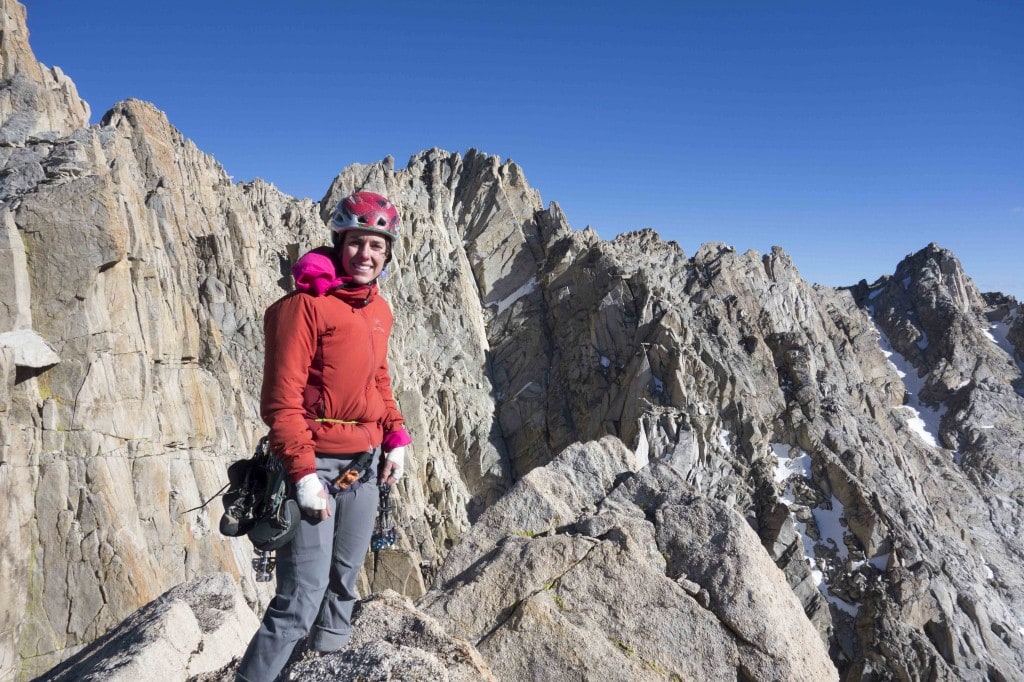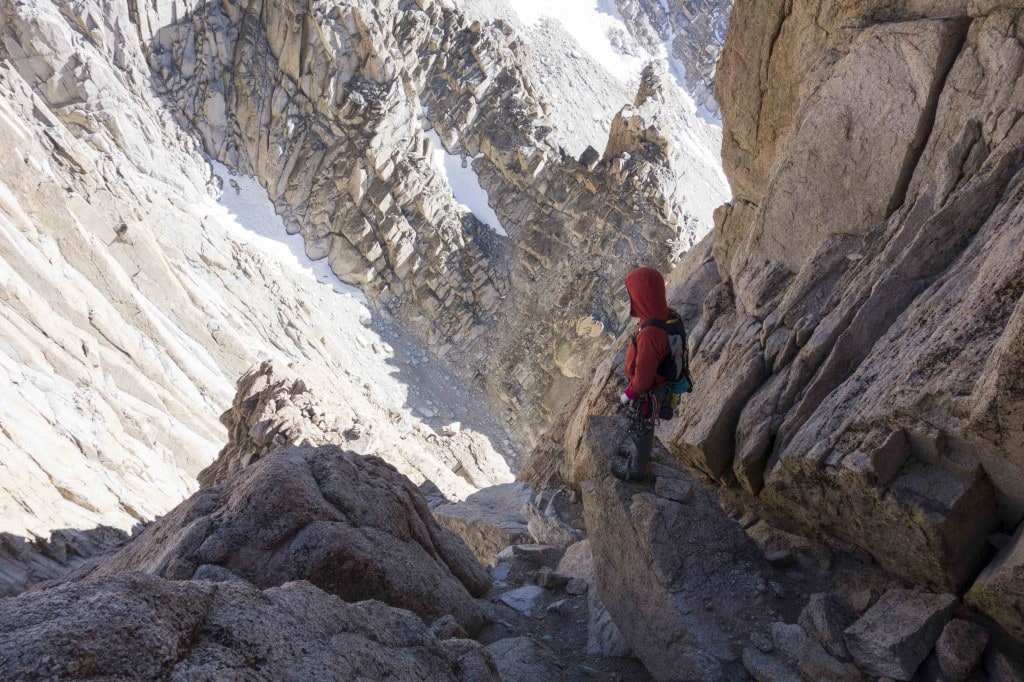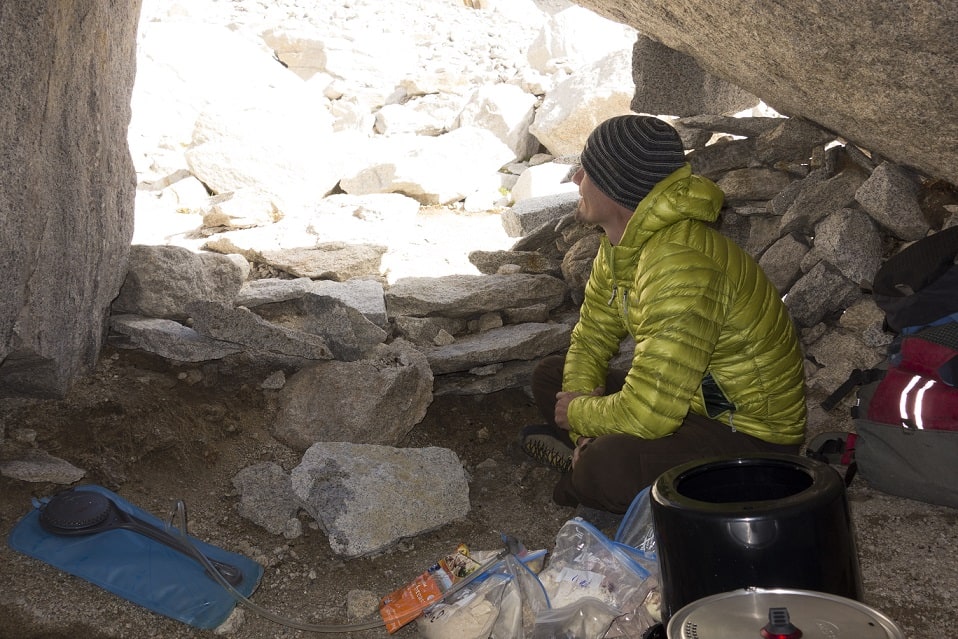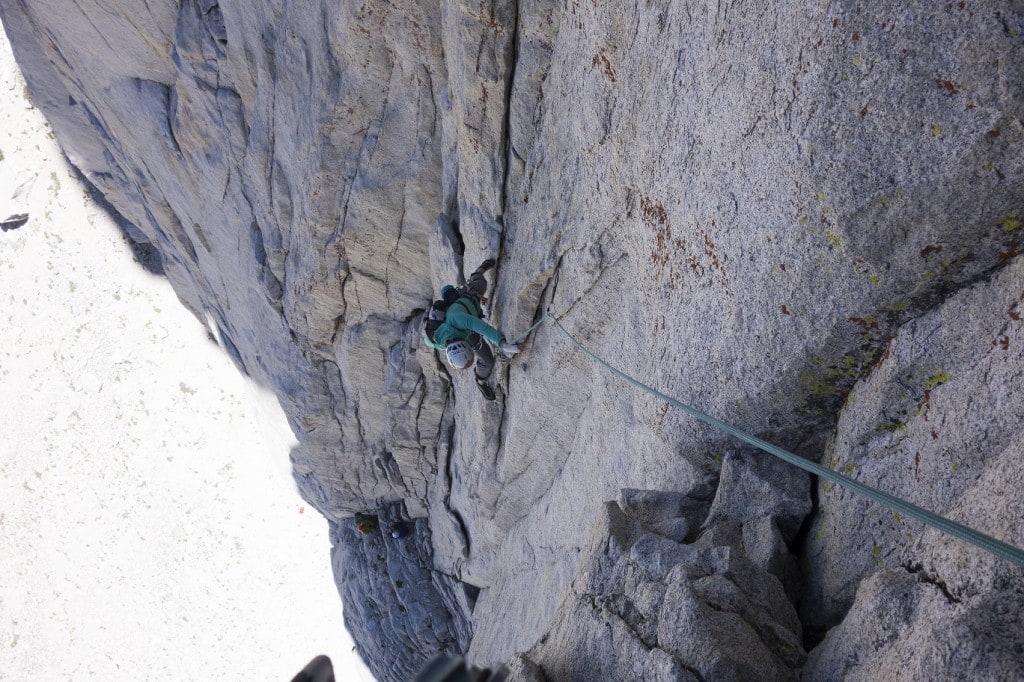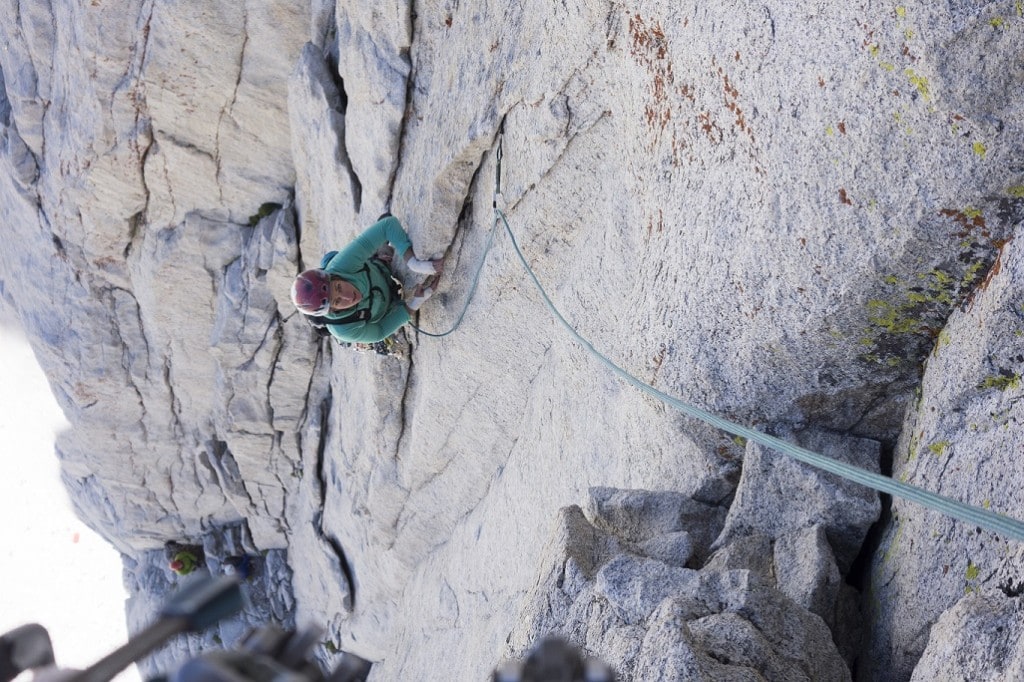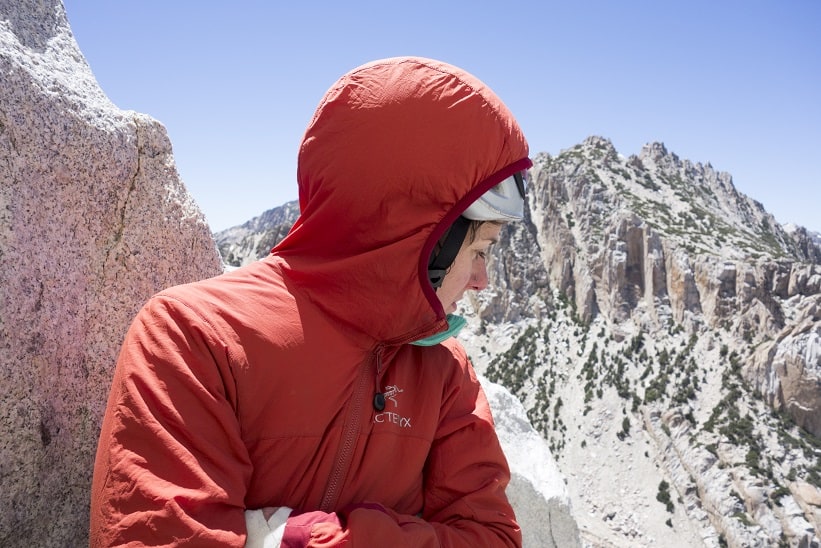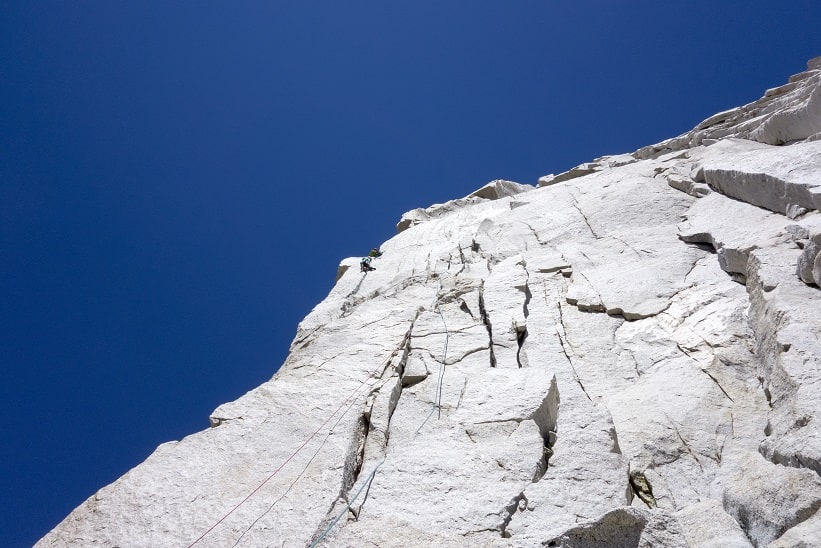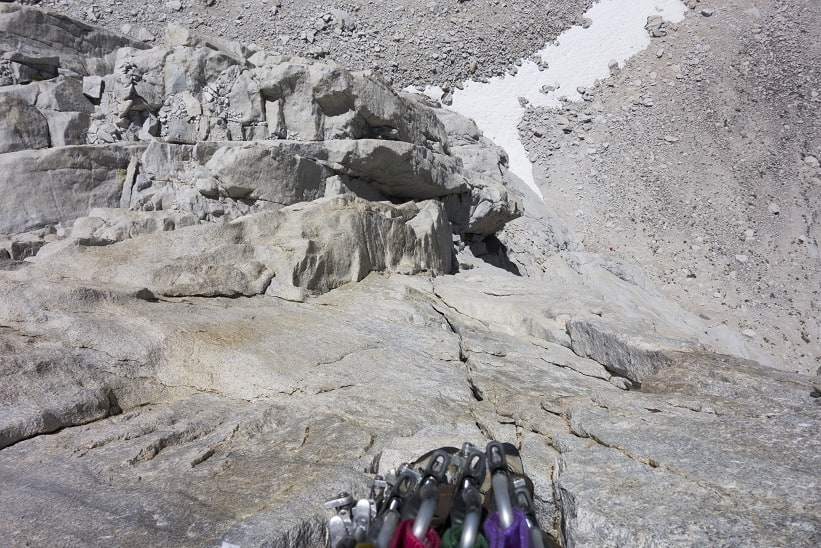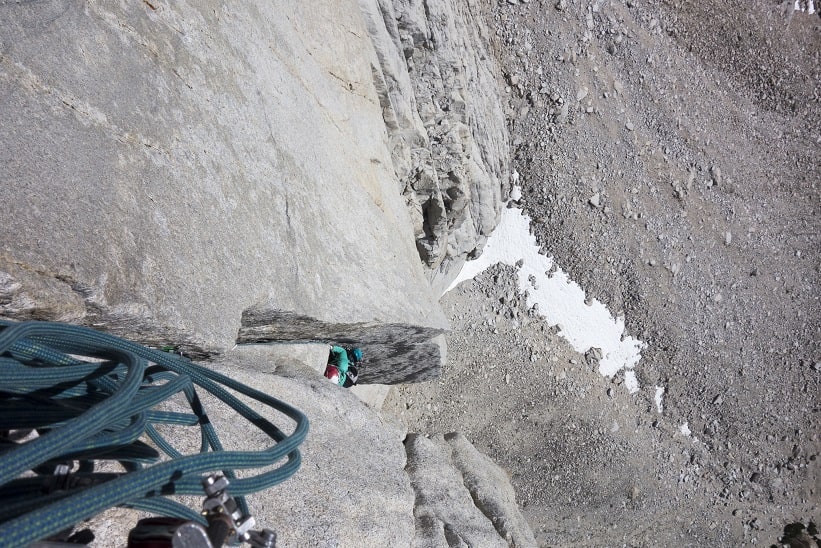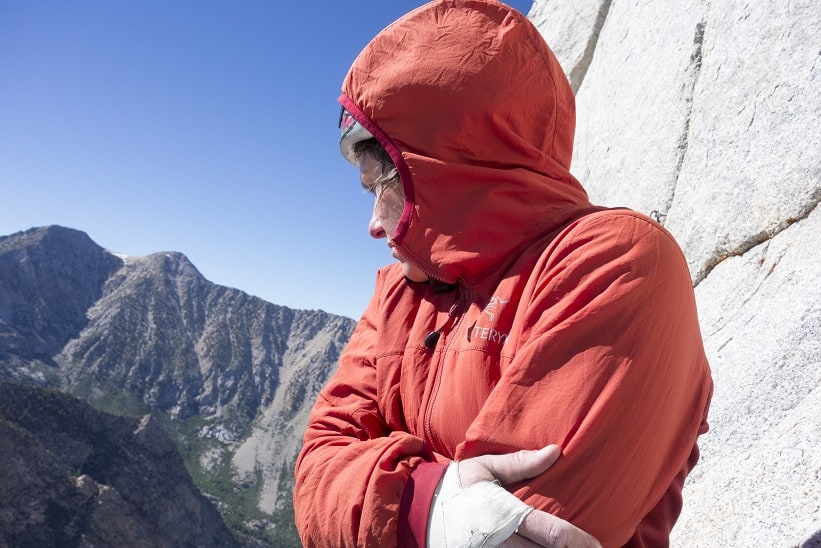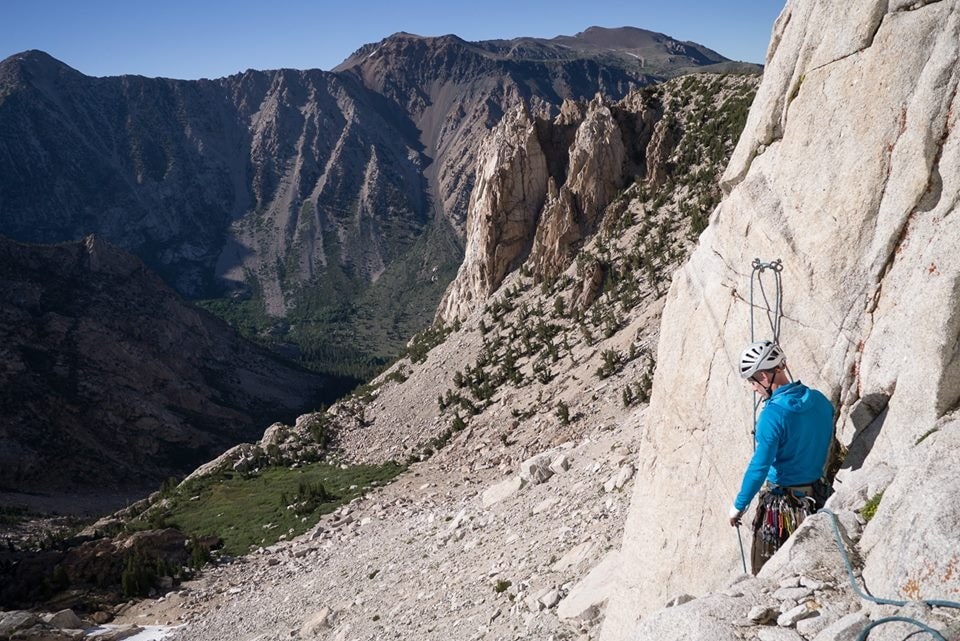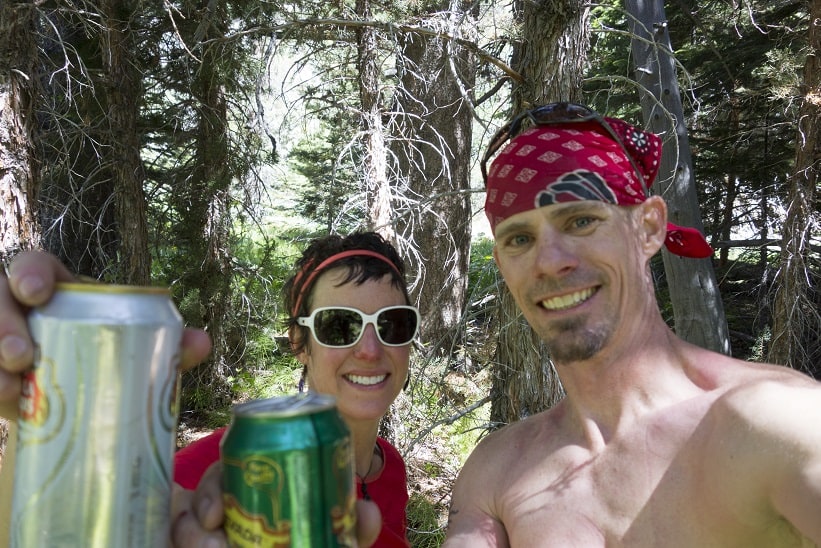Successes and Failures Rock Climbing at The Incredible Hulk
My favorite alpine partner, Polly (who is also my sister) and I had been planning a return to The Incredible Hulk since our last visit a year ago. We had some unfinished business with the route Positive Vibrations, as well as some new business to attend to on a couple other routes. For those who have no idea what “The Incredible Hulk” means to climbers, I can tell you it isn’t a funny green man with an attitude, but rather a piece of granite with a reputation. More specifically, beautifully sustained and varied 5.10+ climbing (Yosemite grades) on perfect rock (no, I’m not exaggerating, it is PERFECT), all at an altitude of 11,000 feet. In short, it is my favorite alpine environment in the United States. When I say alpine, I generally mean multi-pitch rock climbing at an elevation near the tree line and in an environment where weather is a complicating factor. Here’s a picture of what we were up to.
I picked up Polly at the Ontario, CA airport and headed north towards Bridgeport, CA. Bridgeport is located about an hour north of Mammoth Lakes, CA, and is the closest town to Mono Lakes area (staging area for the approach hike into the climbing area). Polly has an immense social standing in the rock climbing community. It is really amazing just how many people Polly knows. I definitely benefit from this social elite-ness in many ways, and on this trip, we ended up staying the night with a “friend of a person who followed a blog and had an honorable mention in a blog that Polly reads”. Or something like that. Any way, we ended up staying the night in Mammoth with a couple climbing guides that Polly knew from an obscure social reference. Simply awesome how the climbing community gets along so well and is so friendly! Climbers are such great people. And guides all get along so well! It was really nice to cook on an actual stove, not have to break camp in the morning, and get our packs organized inside (while it was raining outside) in the morning. We arrived in Bridgeport about an hour after departing Mammoth and stopped by the Ranger station to pick up our back country permit. This ferociously posed stuffed beaver (really funny!) is in the front office of the Bridgeport Ranger station. Polly posed in front of the beaver for a pic.
After parking the car at the Mono Lakes campground (this costs $10), we headed up the 5 mile trek towards the Hulk. There are a couple stream crossings on the approach, and we stashed a couple beers in a convenient spot near one of the crossings for a nice “something” on the hike out. My Cilogear 60L pack was pretty stuffed full of equipment. I bet it weighed around 50 pounds. Polly’s wasn’t much better. Inside my pack, I had a 3 person tent, the rock climbing rack (a set of C3’s, double set of aliens from green to red, a set of Metolius ultralight nuts, a set of brass off set nuts, a set of Wild Country Superlight Rocks, (3) 0.75 C4’s, (2) #1 C4’s, (2) #2 C4’s, (1) #3 C4, 14 alpine draws, and 5 quick draws), clothes for a couple days, some protein powder for recovery drinks, a 70m 9.2mm rope, extra pair of shoes, my harness, helmet and climbing shoes, 0 degree down sleeping bag, a water filter, and ThermaRest Neo Air 4 season sleeping mat (I love that mat – so comfortable!). Polly was carrying all of the food for 4 days, tent poles, a 70m tag line, the stove and fuel, a bear box, and all of her climbing equipment. We thought we might be a little on the heavy side, but we were ok with the extra weight a 3 person tent represented. It is just a LOT nicer to crash in a tent with a little wiggle room at the end of the day. As we hiked up the trail, we didn’t feel bad. We had acclimated a night at 8,000 feet in Mammoth, which really helped. Acclimation is a very important part of climbing at altitude. At least for me. I live at around 3,000 feet elevation, and arriving at 10,000 feet elevation and climbing hard definitely is taxing. Every night of acclimation at altitude meant much better performance on game day. The first glimpse of the Incredible Hulk can be quite intimidating. I still remember the first time I turned the corner on the approach hike in and saw the jagged white tooth glaring at me from a distance.
The Hulk is definitely a proud formation. And a beautiful piece of granite. It is typically protected by a bit of snow in June. Both times I have been to the Hulk, we have had to cross a snow field on the approach. While this doesn’t sound too bad, it is actually quite dangerous. I would say crossing snow fields is one of the most dangerous activities you can do as a climber on an approach. Typically, snow fields are pretty far back country. And typically, they are at a somewhat steep angle. The simplest way to cross/ascend a steep snow field is to kick steps into the snow. You kick a step into the snow with one of your toes, stand on that step, and kick a step with your other foot into the snow just above you. Rinse and repeat. While this doesn’t sound terrible, falling down while ascending a snow field can be catastrophic. Without an ice ax, there is no way to self arrest (stop yourself). Once you fall down, you begin sliding down the snow field towards the base, continually picking up speed until you stop against something at the bottom, which is usually a rock. The moral of the story is: don’t fall down. Many people have broken one or both of their legs after falling down on a snow field, accelerating all the way to the bottom, and impacting on a rock. This is bad enough when you are close to medical care. In the back country, things get much more complicated.
While this is dangerous, as rock climbers we are expected to assess risks and take precautions to mitigate them. Rock climbing is a dangerous sport, and good environmental awareness is required. As a rock climbing guide, this awareness is very necessary for acceptable client care. After our approach hike, we set up our camp. The wind had begun to pick up, and this was concerning to us. Windy situations in multi-pitch alpine climbing can become desperate. We pitched our tent in an area somewhat sheltered by trees and then cooked dinner in an awesome cave bungalow some prior climbers had set up as a shelter.
Polly had planned out our meals, and she did a fantastic job! Our meal on the first night was pizza rice. We filtered some water from a nearby snow melt stream, boiled it on our little stove and threw in our meal. Delicious. While we munched on our dinner, we discussed the weather options. The wind was concerning to both of us. The temperature was also much cooler than we anticipated, and a cold blustery day on exposed granite and difficult climbing sounded unpleasant to both of us. More concerning to us was the idea of rappelling in the wind. In order to rappel down a 1,200 foot face, the rappel is broken up into sections. Each section is a rope length and has a fixed anchor. The basic strategy is to feed your rope through a fixed anchor and rappel down to the next fixed anchor. At each fixed anchor, we would have to pull the rope down to us in order to continue rappelling down the face. This meant we would have to pull our rope about 10-12 times before reaching the ground. One of the scariest parts of rappelling is the possibility of getting your rope stuck when pulling it down to you. You pull the rope and as it falls towards you, it tumbles and coils, and sometimes can get wrapped hopelessly around protruding formations. This possibility is compounded in the presence of wind. Wind takes ropes and throws them mercilessly in every direction. We were not excited about this possibility, and as a result, decided on a route that would include a summit and allow us to walk off instead of rappel. This was a mitigation of risk process, and this was important to us. The route we selected for the next day’s outing was the Red Dihedral. While this route didn’t represent our “unfinished business” from the year before, it is a 5 star super classic alpine route rated 5.10. There simply aren’t any “bad” or lousy routes on the Incredible Hulk formation, and we were excited for an “easier” day of super classic alpine climbing. We washed our dinner pot, secured all our food and loose items around camp out and hopped into our cozy sleeping bags. The next morning we got a pretty leisurely start at around 8:00 AM and were climbing by around 9:30. The wind continued throughout the day, and the temperatures were quite cold in the shade. We simul-solo’d (no rope) up to a belay ledge just before a 5.8 corner. Polly took the first pitch and led up the corner and onto easier terrain.
I took the second lead and linked an insecure 5.9 pitch and a pitch with a section of “poor pro” 5.7 followed by more 5.9. This deposited me at the base of the red dihedral proper. The climbing was quite sustained, each move being near the rating of the pitch. I had to work some magic to keep the protection reasonable on the 5.7 section. The Wild Country Superlight Rocks really came in handy on the tricky pro section. I rested when I needed to rest, and while resting looked ahead at the next section and next protection opportunities. I was climbing well, in spite of the wind and poor protection. The shade was frigid, and my whole body shook from the cold while I waited for Polly to follow my linked pitches.
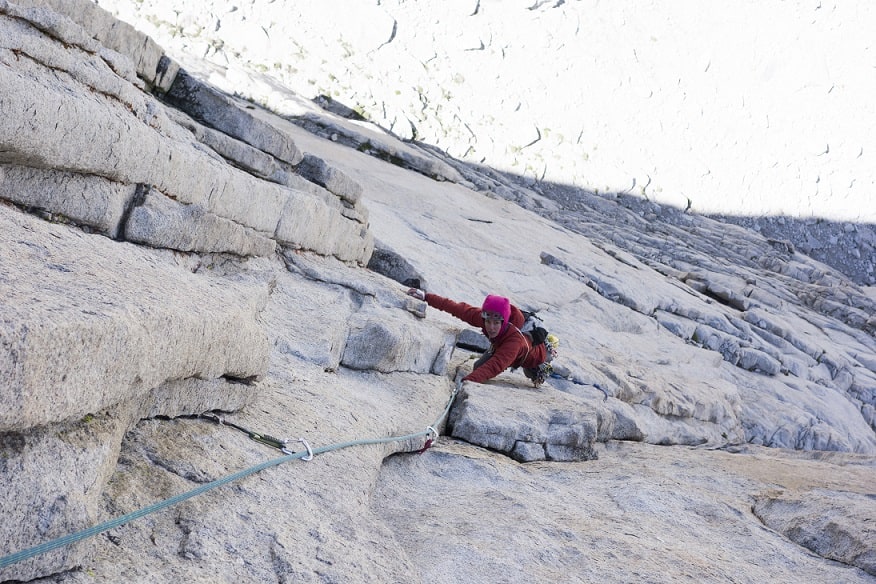
Polly following pitch 3 on Red Dihedral
Once Polly reached the belay ledge, I put on my nice puffy jacket and felt instantly better about life. The next pitch was the “money pitch” of the route, and Polly was very interested in leading it. The pitch was the reason for the route, a namesake Red Dihedral pitch that looked quite nice!
While this pitch was quite good technically, it was very very sustained. Every move was just as hard as the last and there were no easier sections for resting or recovering. Once the corner began, it was continuous jamming throughout the rest of the pitch, some of which felt quite insecure to me. The top of the pitch held a 5.10 move that guarded the belay; the only 5.10 move the topo mentioned on the route. Polly sniffed it out and sent it first try, giving a cheer from above at the belay. She put me on belay and I started after her, excited at the prospect of exercising and shaking off some of the cold and stiffness that had set in. I was pacing myself well, not racing through the pitch, and I was still getting extremely out of breath. I could tell I was definitely feeling the effects of the altitude. The 5.10 move felt marginally harder than the rest of the pitch. That seems to be the situation on a lot of the climbing at the Incredible Hulk. The climbing is sustained, and the difficult sections are marginally harder than the rest of the climbing. In essence, the real difficulty is not technical but rather endurance based. Being able to pull a marginally more difficult move after climbing 100 sustained feet at elevation is what makes this mountain a tough place.
After this namesake pitch, the climbing did ease off a bit, and I was excited to be in the sun for a few pitches. The route finding did get a little worrisome. It was difficult to discern from the Supertopo topo where the route actually went at this point. As I climbed, I took my topo out of my cargo pocket on my pants a few times to make sure I wasn’t heading in the wrong direction. It is easy to get off route in these types of environments, and you can suddenly find yourself accidentally in very difficult terrain or down climbing to get back on route. The absence of chalk or other discernible markers on the rock creates an atmosphere similar to climbing into unknown territory on a first ascent.
The environment in alpine climbing is a large portion of why I love alpine so much. The scenery is breath taking. When the climbing gets hard or you get scared, you simply have to pause and take a look around you for a moment, and the beauty of the experience brings your mind back into the positive realm of thinking. The beauty in these moments is often overly stimulating to your senses. You may find your soul being replenished as you climb; this can be dangerously addictive! Polly and I transitioned leads throughout the rest of the climb. There was only one other really noteworthy pitch in the upper sections of The Red Dihedral. The topo called it a 5.9 hand crack. I got the privilege of leading this pitch. The hand crack was beautiful, protected well, with excellent rock quality and amazing position on the side of the wall. An amazing pitch! I linked the last two pitches to the top of the ridge and brought Polly up. I’m not entirely sure if I stayed on route or not on those last two pitches, but followed the line of least resistance. We were using a 70m rope, and I was glad to have it. There wasn’t much rope left after linking the last two pitches. I built an anchor at the top out of a #2 and #3 C4. I brought Polly up and we headed/scrambled climber’s right over to the last bit of climbing – a dirty chimney followed by the “birthing canal”.
The last two pitches above the summit ridge proved to be quite the adventure. There was a LOT of snow near the summit. I actually had to stem in the snow to begin the dirty chimney pitch. As I was stemming up the snow, my foot poked through the snow and my shoe got completely wet. At this point, my attitude took a turn for the worse. I was quite tired, wanted to be at the top, and didn’t want to deal with this dirty chimney, especially with wet shoes. I climbed up the chimney, and it seemed very tricky to me for a 5.8 pitch. I suppose there is a 5.8 way to climb it, but with the gravel/dirt on the rock, the slippery wet surface, and wet shoes, it seemed a good deal harder to me than 5.8. Above the chimney was a ledge with a layback corner. The layback corner was slightly overhanging and was wet and dirty as well. I laybacked up the corner and forced myself to step onto the slopey ledge above that was covered in gravel. Not excited. I continued up another section of chimney and stopped just short of the birthing canal. I wasn’t sure what kind of anchor I would get on the other side of the birthing canal hole, and I was staring at a very reasonable spot to build an anchor. I made a belay and brought Polly up. From the expression on Polly’s face as she joined me at the anchor, I could tell her experience in the chimney, layback corner, and second chimney was about the same as mine.
Polly led up through the birthing canal and snapped a picture of me as I exited (somewhat dramatized for comical value).
From here, we walked up to the summit, took a breath and looked around. As I peaked over the ridge, the wind hit me full force. Yes, it was still quite windy! We of course took the mandatory summit shot and signed the summit register.
From the summit, we headed right and down a ways to the fixed anchor for a rappel. We were glad to have summited during daylight as this allowed us to see the rappel anchor from the top and before we started down climbing towards it. The down climbing wasn’t horrible, but it also wasn’t trivial. Utmost care needed to be taken during this portion of our climbing day. Getting injured at the top of a mountain really isn’t an option, and we were both tired. We down climbed and walked along a spectacular ridge line towards the anchor, rappelled off, and skid/scrambled down the seemingly infinitely long dirty loose scree field to the base. The whole deproach took us about an hour and a half, although it seemed much longer. We were back at our camp site at 6:30 PM with plenty of light to make dinner and get ready for bed.
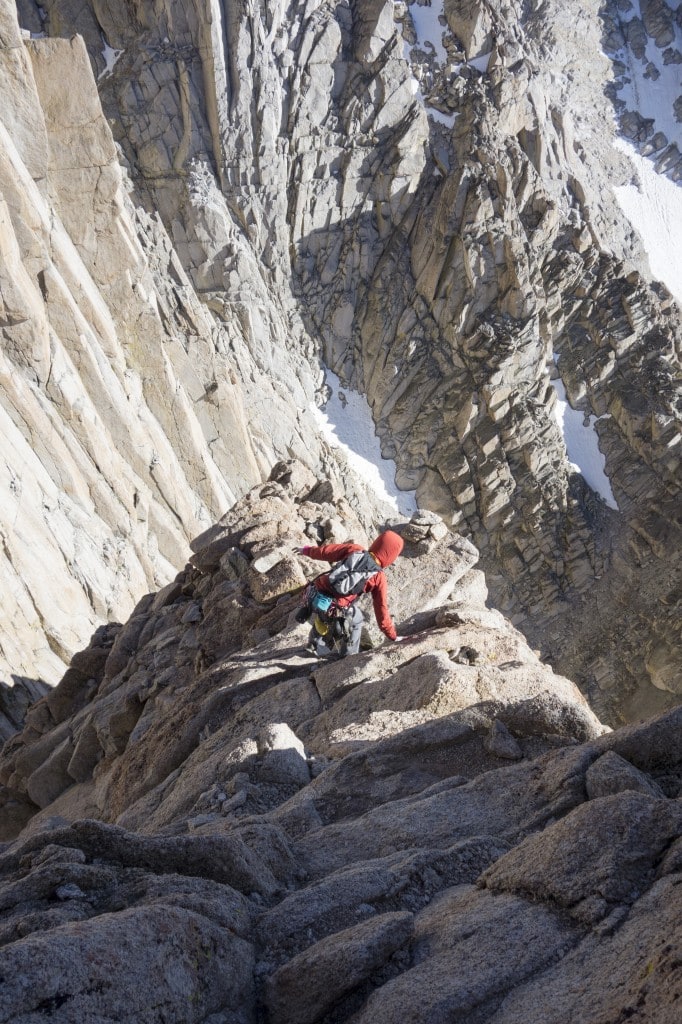
Polly on the ridge line
After we got back to camp, we filtered some more water, got dinner going, and discussed the next day’s objective. Both Positive Vibrations and Sunspot Dihedral were on our list of climbs for the weekend. Sunspot Dihedral was in the shade, and the weather on Sunday was supposed to be much warmer. We decided to put off Sunspot Dihedral until the next day and focus on Positive Vibrations. The wind was dying down, and the weather was holding steady which was great for rappelling. Sierra alpine weather simply can’t be beat! Beautiful sunny cloudless days. As Polly was boiling water for our delicious dinner, I stared up at the rock face. I could see the entire line of Positive Vibrations, and I was remembering the beta from the prior year and thinking about the upcoming long day ahead of us. This climb was our unfinished business from the year before when we retreated due to a hail storm.
We ate our dinner, washed up, stashed all of our food and loose items again, aired out our climbing shoes, and crawled into our nice cozy sleeping bags, tired but happy with a fun safe successful day.
The next day we woke up around 7:30 and got moving. It was excellent and unusual to get a full night’s rest at an alpine mountain, and we were loving it! We got started on Positive Vibrations around 10:00. We decided to lead the same pitches as we had led last year. Luke Stefurak and Josh Janes showed up at the climb shortly after we did. Always nice to have company! They are both great climbers and awesome stoked people, and it was great knowing they would be on the same climb as us. They were going to use Positive Vibrations as an approach climb to project the upper pitches of Venturi Effect. Stout stuff! As Polly started up the first pitch, and I was feeling a sense of dread about my upcoming leads. I didn’t feel strong, I didn’t feel like I had rested well, and I was quite nervous about getting on the sharp end and pushing through some sustained 5.10 terrain. Polly led through both of her 5.10 pitches without mishap. She was climbing really well, and she was excited about her accomplishment on these two pitches. On the other hand, I was feeling rather tired and worried about my upcoming leads. I could tell The Red Dihedral had taken quite a toll on me, mentally and physically. At the first belay, I told Polly where I was at, and she said that she had met her objectives for the climb, was happy with her leads, and was ok with taking the climb as far as we wanted. I am glad we talked about this; it is always good to let your partner know where you are at in your mental space. It helps them understand what is going on in your head as you are leading and provide a better belay. I said I would probably feel better after a couple leads. This is typically the case. On most hard climbs, my brain has serious hesitation, my body feels anxious, and I feel lousy until I get a few leads under my belt. I reminded myself this as I headed up the third pitch on lead. I made myself focus on the present, one move at a time, one sequence at a time, one pitch at a time. My brain can process these pieces of the climb; the entire climb all at once is a bit much for me to process and creates feelings of anxiety and anticipation. I sent the third pitch easier than I expected, which surprised and excited me, and I started feeling a lot better about the day.
Polly took a look at the crux before committing. I managed to convince her to use the same beta I had used which involved a rather hard stem. My beta was horrible for her! Her legs are definitely not as long as mine..
In retrospect, I should keep my beta to myself, especially in the presence of experienced climbers with completely different body compositions. Me convincing people to use my beta is not giving them the ability to process the climb on their own and make their own wise decisions. Sometimes I get really excited about a particular sequence, want others to succeed, and feel that if I can help them succeed they will also be excited. In these moments it is rather hard to keep quiet and let others find their own way and success.
At the belay, I looked up at the sustained fourth pitch and remembered how strenuous it had been the year before. Nearly every move was 5.10, and I was nervous. The first move off of the belay is rather committing. It requires you step out over a chasm and stem a foot out across to a wall. Exposure has always been my weakness, but after the success on pitch 3, I was feeling a bit better about where I was at. I stepped out, placed a cam, and started stemming up the chimney. The pitch went much easier than the prior year, and I was pleasantly surprised. The stemming was solid, there was plenty of gear options, and I had some good opportunities to rest. I approached the first roof, wondering how hard it was going to be to pull. Instead of pulling through the roof, I simply stemmed a bit further back into the chimney and stemmed right around it! I felt like I somehow cheated the roof, but I was really having fun now. At the top of the pitch, I put Polly on belay and brought her up, hoping she had experienced something similar on the pitch. And then this happened.
Unfortunately, Polly’s experience was quite different than mine. She was really getting tired, and had slipped and fallen twice already. She was starting to get to the place where she wasn’t having much fun, and the climbing felt too hard and a lot like work. I remembered how much she had enjoyed leading pitch 5 the year before, and I somehow managed to convince her to lead it again. I could tell she was really digging deep and doing this for me. She is a great partner like that! I was really secretly hoping she would send pitch 5 and get stoked again. We let Luke and Josh climb past us; they really are faster climbers, and we didn’t want to be in their way.
Polly sent the 5th pitch with good style. I was totally impressed! And I was really hoping this success had gotten the stoke going again. I followed up the amazing hand crack, glad that Polly had led it. The position on this pitch is simply incredible. You are literally perched on the side of a sheer cliff on excellent rock with good jamming. There is an awkward pod at the base of the crack that requires a little thrutching to get past, but after that, the pitch is really excellent. I took a picture while on the crack just to show how sheer the face is and how exposed the climb is.
I reached to belay to find Polly in somewhat better spirits but still looking quite tired. The pitch 5 belay is really quite awkward. Pitch 6 starts by traversing to climber’s left (past the belay) for about 6 feet to a dihedral. Traversing past Polly was a little awkward, but we eventually managed to get situated and ready for my next lead. Pitch 6 was what I remembered as the most physical pitch on the climb (at least what we had completed). My mind was in a bit of a strange place. I had been successful on the beginning of the route, and it had been a bit easier than I remembered it being the first time. Maybe this pitch would also not be as bad? We broke the pitch into two last year to reduce rope drag, and that had worked well, so that was the plan again this year. I traversed over to the corner and put in a micro offset nut and backed it up with a purple c3. Upon entering the corner, I could no longer see Polly, which also added a bit to the mental processing of the corner. This pitch is the reason I brought these offset nuts. The only real pro available on this pitch for the first 30 feet in the corner is all offset micro nuts. I placed 4 nuts in the corner as I stemmed up. Trusting those micro nuts below me was mentally taxing, and I was relieved to reach a bit of a rest near the top of the corner. I still couldn’t quite reach the next pro option, a yellow alien placement, but at least my calves could de-pump for a minute and I could shake out the mental jitters. After (not enough) resting, I pressed upwards and placed my first decent cam in 40 feet – a yellow alien – under a roof. The route now traversed out to the right for about 10 feet and went around the roof on the right, and up a 0.75 crack for a ways. I lay backed out under the roof for a couple moves and placed a #3, slung it long, and then continued along the roof. As I reached the corner, I was trying to remember from the previous year how I had climbed around this corner. I looked around for feet, to no avail. Now about 4 feet past my #3 with fully extended sling, it was go time. I lay backed around the corner and reached up to try to find a good jam. There wasn’t one. Now I was really pumped, and as I tried to make one more lay back move, I popped off. I yelled to Polly (who I still couldn’t see) “Falling!”, and went for the ride. It ended up being about 25 feet, but Polly caught me, and I was OK. The #3 held like a champ. I rested and yelled down to Polly to see if she was OK. She was, although she had been pulled toward the corner pretty hard and had scraped her brake hand on the rock. After a few moments, I went back up to the corner and lay backed around the roof and stood up. I had been one move from victory. I got a 0.75 c4 in and took a breather. Then I progressed up the strenuous corner towards the top. Thankfully, I had slung all of my gear well enough to prevent horrendous rope drag. The top of the 0.75 crack ended in a strenuous roof, which I still had to pull. I got a #1 in below the roof, and reached up and groped around to find anything that might give me purchase to get over this roof. I was thoroughly exhausted by this point, stemming hard, groping for holds, and feeling quite pumped again. I found a shallow flared hand jam. Surely there must be something better than this! More groping led me to the conclusion that my best option was the shallow flared hand jam and a hard stem to pull over this roof. I finally committed and made the moves. I was too exhausted to place gear! I panted and panted and tried to catch my breath, and finally was able to put in a piece. After a few more moments, I put in two more pieces, made an anchor, got tied into it, and called down to Polly “off belay!”. I pulled up the slack between us and got Polly on belay. I had a feeling this pitch was going to be particularly nasty for her. Polly came up the corner and made it all the way to the roof before she had to take. I was impressed!
Polly made it up to the belay, got into the anchor, and then this happened.
Secretly, I was hoping that she would feel this way. I was exhausted. I didn’t know if I could do the rest of the climb. It was one of those moments when you feel like you really can’t wait to be on the ground. I decided to rest for a few minutes, drink some water, eat a little bit of food, and see how the situation played out. Polly was honest with me, which I appreciated. She said she wasn’t really interested in continuing, that we were past the “fun” threshold and into the “ugh” area. I didn’t need a lot of convincing. I was beat. The thought of continuing seemed impossible; my brain rejected the thought. We both had the technical skills and the abilities, we just didn’t have the energy. I relaxed, flopped onto my stomach, let my body go limp against the rock and hung from the anchor. It felt SO good to relax and not use any more energy at this point. After a bit of conversing, we decided to bail. We could come back and finish this route when we were in better spirits and had more energy.
While bailing is not a proud option, it sometimes is the best option. We had done well to make it this far. We were ok with our progress. We knew that we were extremely exhausted, and we wanted to make it a fun and safe day. We had completed a majority of the route, but we weren’t ready to complete the last sections. I would rather bail on a route than pull my partner up, especially if they are not having any fun. I like my partners too much! And I honestly didn’t know if I could complete the rest of the route in good style. I was exhausted. I didn’t want to make stupid mistakes or hang all over every pitch. We were in the mountains, and this was no place to “mess around”. I do believe that “just because you CAN do something doesn’t necessarily mean you SHOULD do it”. We both talked about it, and both agreed that we were extremely ready to be on the ground, warming in the sun, and off of our feet. We left a #2 and a nut in the rock, bailed down to the first fixed anchor, and rapped to the ground. We sat at the bottom of the climb, basking in the sun, and feeling really good about life. A really nice climber we met later that day offered to get our gear down and mail it to us. I was extremely grateful. Climbers are such awesome people!
Polly and I had planned on climbing three routes on our trip to The Incredible Hulk this year. This was mostly because of the amount of time and money a trip to the Hulk costs. We wanted to make it “worth while”, and thus over planned our trip enormously. While we were successful on The Red Dihedral, the “unfinished business” route Positive Vibrations remained unclaimed. And we were dead tired. We still had another day planned for our time at the Hulk, but we both knew that neither one of us had it in us to get on another hard route the next day. At 10,000 feet elevation, bodies recover much slower than at sea level. If we wanted to try another hard route, we would need at least one good rest day, and we didn’t have that in our schedule. We had underestimated the amount of energy The Red Dihedral had siphoned from our depleted energy tanks, and we had over estimated our recovery abilities. We cooked our dinner, hung out, and talked about our climb. Later on, we visited with Josh Janes and Luke Stefurak at their camp site. Luke Stefurak is a huge advocate for The Incredible Hulk. He is there constantly and has done a lot of work on maintaining bolts and anchors, and I have utmost respect for him. Josh Janes is an awesome individual as well. He guides in Red Rock Canyon near Las Vegas and has dedicated his life to assisting others in their pursuits of life experiences in the realm of rock climbing. I have recently also begun this journey, and I relate heavily to others in our industry.
Polly and I had succeeded in many ways, and failed in a few. We had both succeeded in climbing The Red Dihedral onsight. We had made it safely back to the ground and to camp. We had made it safely to the middle of the 6th pitch on Positive Vibrations in good style. We had planned the trip well, brought enough food, water, proper gear, and stoke for the climbs. There were many things that we did well, and probably took for granted, that many people might have trouble with. We were happy with our successes. However, we had made one big blunder. We had underestimated the energy required to complete The Red Dihedral, and underestimated the amount of energy cold weather could sap from us when we shook from the cold at belays. We had also overestimated our ability to recover. We weren’t over our heads, we just pushed past our multi-day endurance level abilities. These were all mistakes that we could readily learn from to avoid another bailing situation. I am OK with failing as learn as I can learn something from the failure. In my mind, the number of successes on our trip far outweighed the failures, and as such our trip was a success. I am very thankful to have Polly as a climbing partner. She is a very solid trad climber with good mountain sense, an excellent sense of direction (important for approaches), and a positive outlook on life. She has a multitude of alpine and climbing experiences and great risk analysis and common sense skills. I would “fail” with her on a route any time!
Polly and I decided to hike out the next day and possibly climb something in Tuolumne Meadows in Yosemite. As we hiked out, we were still in good spirits. The Incredible Hulk is a beautiful alpine piece of granite that is hard, but that is why it is also rewarding to me. If it was super easy, it probably would not be as meaningful. I am grateful to have the skill set to attempt and succeed and fail on the Incredible Hulk, and I look forward to me and Polly’s next attempt at our “unfinished business”. We have vowed to return again next year and complete the route. We have learned from our simple mistake of over planning and over exerting, and next year we will only return to complete one route. Along our hike out, we retrieved our beers from the river and toasted to another year of great adventures on The Incredible Hulk.
July 18, 2014. Posted by: nelsonday
